Listen, O Devi, I will speak concisely of the essence of yoga. The body resembles a tree, with the root above and the branches below. In the macrocosm there are tirthas (bathing places) which also exist in the body. The macrocosm is like the microcosm. ~ Todala Tantra, II
Liberation comes from knowledge of self. ~ Kaula Upanishad
Within the realms of Hinduism, the concept of god (Brahman, or the Paramatma-Supreme Soul) comes as both saguna (with attributes, where there is a form and gender) and nirguna (where god is formless and infinite). The nirguna concept, which is based on higher level philosophical thoughts is difficult to comprehend or even visualise. It has always been easier for the common people to follow the saguna form of worship, where their revered god takes an anthropomorphic form. This need to see the revered deity in front led to the development of murtis and their worship. Thus, we see the Shaivites worship Shiva as their supreme god, and the Vaishnavites worship Vishnu as their supreme god. There is a third group that worship the female Energy or Sakti as their supreme god, the Devi. This group of worshippers is known as the Saktas, and they worship the feminine power as the main god. Here the Devi is not limited to being just a consort of a male devta (as we see in Shaivism and Vaishnavism), but she is the one in focus as the main deity.

Worshipping the female energy or principal goes long back into Indian history, and like in other parts of the ancient world, its worship started in the remote pre-proto historic era. Many artefacts from the Harappan civilisation show the presence of the Mother goddess form of worship. The most commonly obtained artefact from the various IVC (Indus-Saraswati or Harappan civilisation) sites are pottery remains with a female figure wearing a girdle and a skirt. As Mackay would write “these pottery images of the goddess whose name is unknown were kept almost in every house in the ancient Indus cities, probably in a recess or on a bracket on the wall.” Aniconic form of worship was also prevalent as seen in the ring-stones available from various sites of the IVC. Similarly the seal from Harrappa, which depicts a goddess with a tree emerging from her womb, is comparable with the later period lajja gauris (as seen in the image given below); and this association of the devi with vegetation matches the Shakamabhari concept found in Devi-Mahatmya, where the devi provides nourishment for the famine afflicted people from her own body.
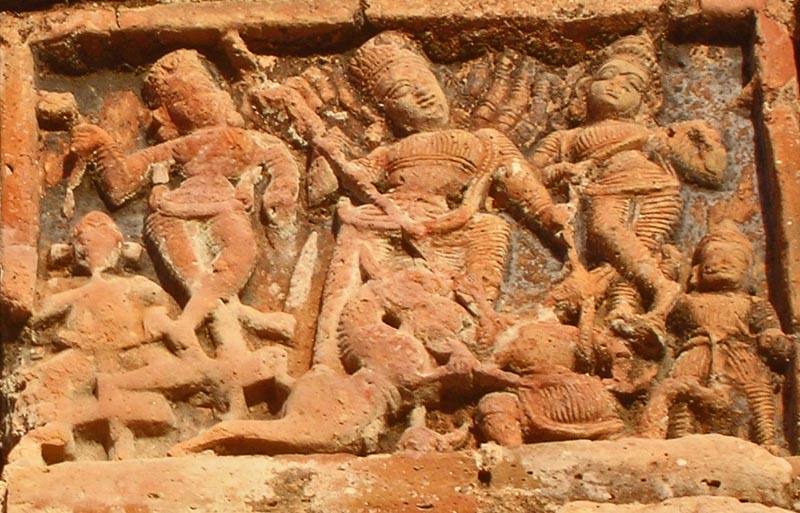
The Rigveda doesn’t mention names of those devis that later came to represent the Sakta cult (Rig Veda has names of other devis such as Aditi, Usha, etc, that are mentioned in the next paragraph here); however these names, such as Ambika, Shri, Durga, etc., started appearing in the later Vedas. Thus, we find that Ambika first appears as a devi and Rudra’s sister in Vajasaneyi Samhita and Taittiriya Brahmana; while in Taittiriya Aranyaka she is mentioned as Rudra’s consort. Durga Vairocani is mentioned in Taittiriya Aranyaka (10th book), where she is described as Katyayani and Kanyakumari (in Durga-gayatri). Shri first makes an appearance as a devi in Shatapatha Brahmana; while the devi is named variously as Bhavani, Bhadrakali, and Durgi in later Vedic works such as Griha-sutras and Sankhayana. Thus, it is clearly evident that the devi concept as we see in the Puranas and the Epics, take a firmer shape and form in the later Vedic period.

Interestingly, while the Rigveda at a superfluous glance gives little importance to the female energy, a closer study will reveal that the devis present in it are quite striking in their concepts. When one reads the verses attributed to Usha (goddess of dawn), Ratri (goddess representing a starlit night), Vac (the goddess of speech), Saraswati (the river goddess), Ila (goddess of abundance), Aditi (the divine mother), Prithvi (the earth goddess), etc., one cannot ignore the feeling of an underlying importance given to these devis that were seen as a manifestation of the great female energy. Of these devis, Vac or the goddess of speech, occupies an important position, as she comes to exemplify the divine Energy or Sakti, omnipresent in all living organisms. This is what is seen expressed in a sublime manner in the 8th verse of the Devi-sukta, and this later becomes a part of the central theme of Shakta puja followed in the later eras.

Developing an image of Devi Durga for the saguna worship
The two well known Durga stotras in Mahabharata (recited by Yudhisthira in Viratparva and Arjuna in Bhishmaparva) and Aryastav III in 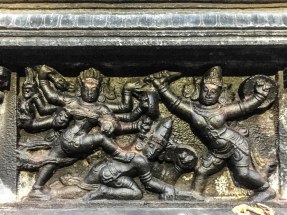 Harivamsha (which is addressed to Yoga-nidra, an aspect of devi Durga) gives us a clear picture of the various images or aspects associated with the Devi. From being a mother, a daughter, and a sister, to a deity who is highly revered and worshipped, the characteristics attributed to her combine many aspects that weaved together the Vedic and non-Vedic worship practices. From being worshipped by the Kushikas and Katyas (Vedic rishi clans), the devi is also worshipped by the Shavaras, Pulindas and Barbaras (Shavarairbarbaraishcaiva pulindaishca supujita). Devi Durga is also referred to as Aparna, Nagna- Shavari, and Parna-Shavari.
Harivamsha (which is addressed to Yoga-nidra, an aspect of devi Durga) gives us a clear picture of the various images or aspects associated with the Devi. From being a mother, a daughter, and a sister, to a deity who is highly revered and worshipped, the characteristics attributed to her combine many aspects that weaved together the Vedic and non-Vedic worship practices. From being worshipped by the Kushikas and Katyas (Vedic rishi clans), the devi is also worshipped by the Shavaras, Pulindas and Barbaras (Shavarairbarbaraishcaiva pulindaishca supujita). Devi Durga is also referred to as Aparna, Nagna- Shavari, and Parna-Shavari.
While the interpolations (khilas) in the Mahabharata shows the devi’s significance, the other epic Ramayana, doesn’t give much insight on the worship of the devi or Sakti. The part where Rama invokes devi Durga and worships her while facing difficulties in the war with Ravana is found only in the Bengali Ramayan written by Krittibash. In the original Ramayan in Sanskrit we find that muni Agastya tells Rama to worship Surya and ask for his help to fight Ravana (Yuddhakanda).
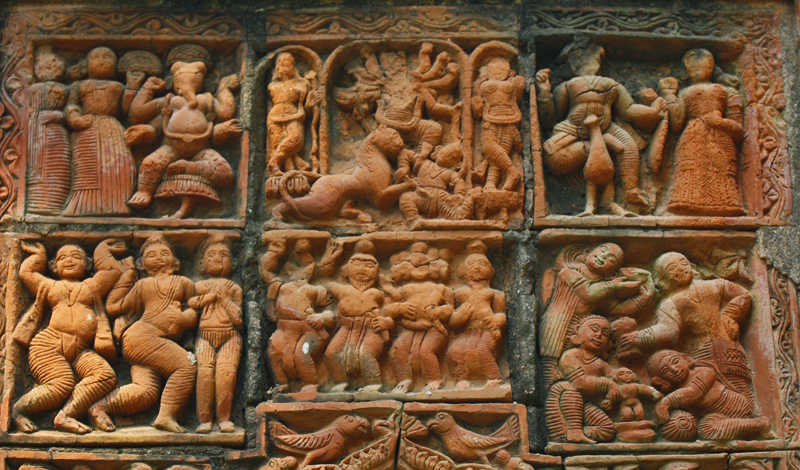
However, unlike the Ramayana, the Puranas are full of devi-stutis that help us in understanding the characterization of devi from various composite strands. Among the various stutis the most important ones are found in the Devi-mahatmya section within the Markendeyapurana that contain the Narayani stuti, Brahma stuti, and Shakradi stuti. In the last few verses where the devi speaks, she tells of reincarnation, the various forms that she takes in different births in order to protect the three worlds (trailokyasya hitharthya) and kill the evil forces (danavas).
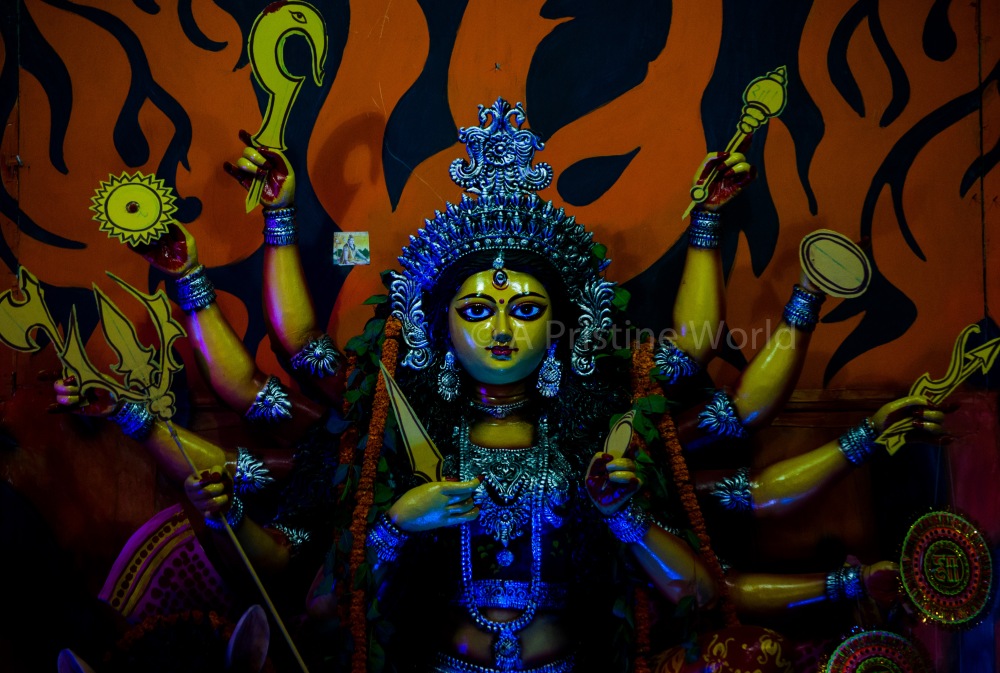
इत्थं यदा यदा बाधा दानवोत्था भविष्यति ।
तदा तदाऽवतीर्याहं करिष्याम्यरिसंक्षयम् ।।ॐ।।
“ Whenever trouble arises due to the advent of the demons, I shall incarnate and destroy the foes. “
(Markandeypurana, 91.51: Eleventh Chapter of the Devi Mahatmya: last couplet of Narayani stuti).
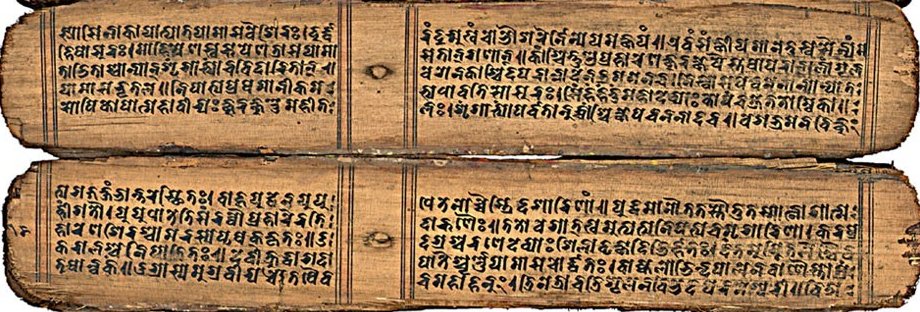
Devimahatmya MS in Sanskrit on palm-leaf, Bihar or Nepal, 11th c. CE, 5 lines in an early Bhujimol script, borders marked with double lines with orange pigmentation between lines, 1 miniature in text. Binding: Nepal, 11th c., carved wooden covers, decorated with 10 miniatures, poti with hole for the binding cord. Provenance: 1. Monastery in Nepal (ca. 11th c. CE); 2. Sam Fogg cat. 17(1996):40. Photo from Wikipedia.
Thus, the Vedic verses in Devi sukta and Ratri sukta that subtly define the female energy, find a complete expression in the Durga strotra (Mahabharata) and the Puranas, where the Vedic and non-Vedic elements are brought together to create a complete and unequivocal concept of the devi shakti .
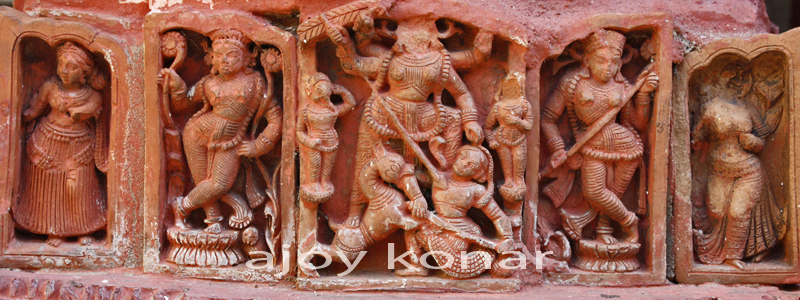
Sakta Worship
While for the Saktas the Devi stands as the Supreme Power in both the macrocosm and microcosm entities, Saktism as a form of worship tends to be aligned with Shaivism in many aspects. The Sakta and Shaiva forms of the Devi are many, and her Sakta forms are also linked to Shaivism in most cases. The Samkhya theory is one such link between Shaivism and Sakta, which expounds the union of Purusha (passive energy) and Prakriti (dynamic energy), where Shiva is the purusha and the Devi is prakriti. Kundalini sakti forms a basic concept of the Sakta worship, which can be awakened through various yogic practices and raised from the lowermost Muladhara chakra to the highest Sahasrara chakra. The process of awakening the chakras from the lowest to the highest is known as Satcakrabheda, and when one successfully awakens all the 7 chakras, he or she can view the Devi in her full glory, and attain moksha.

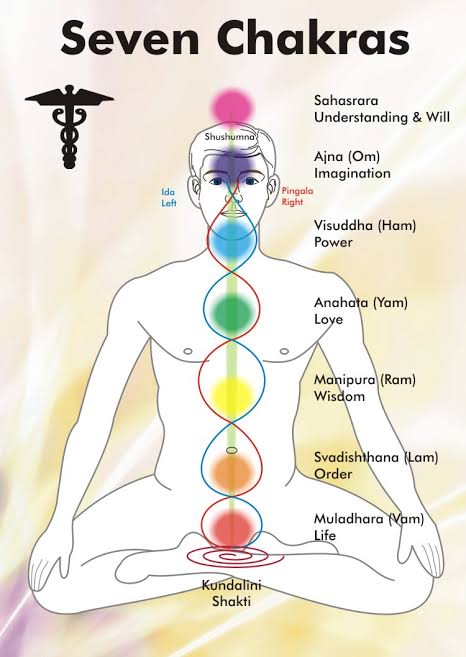
While there are many forms and images of the Devi within Sakta worship, the focus here will be only on her major forms: Durga and her Katyayani-Mahishasuramardini aspects. Durga being an important form of the devi finds a connection to both Shaivism and Vaishnavism.
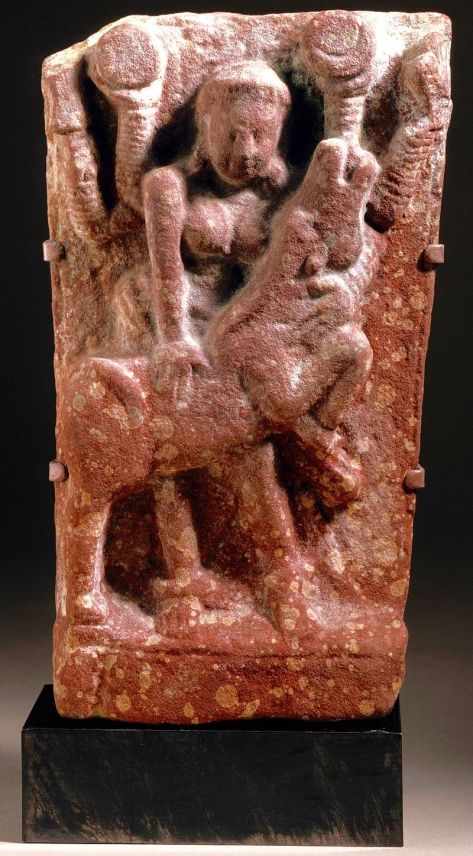
Durga and her two most popular forms: Katyayani and Mahishasurmardini
Durga
Devi Durga, the sister of Vishnu (Surabhedagama), a part of Adi Sakti, can be shown with four or more arms, three eyes, and should be of a dark complexion. She should be made beautiful with a voluptuous body, dressed in yellow clothes, bejewelled, and shown wearing a karanda mukuta. When shown with four hands, her front left hand should be on the hips in a katyavalambita/katisamsthita-hasta pose, while the back left hand should carry the sankha. The right front hand should be in abhaya pose and the back right hand should carry the chakra. The devi should be standing on a lotus seat, or on the head of a buffalo, or should be seated on a lion. A snake should form her breast band, and a red drape should be on the upper part of her body. When depicted with 8 arms, besides carrying the sankha and the chakra, the devi is shown with weapons, such as, sula, khetaka, khadga, pasa, a bow, and an arrow.


Katyayani
The devi is shown with ten arms (which can go up to 18 arms, but that is a rare occurrence), possessing the aspects of Brahma, Vishnu, and Shiva. Like Durga she is also associated with the colour red, and wears a jatamukuta with a crescent moon in it, is youthful, bejewelled, and has beautiful eyes. She is shown with 10 hands carrying pasa, khetaka, ghanta, parasu, and ankusa in her 5 left hands, and bana, trisula, khadga, chakra, and saktyayudha in her five right hands. Below her is shown the Mahishasura, and the devi is shown in the act of killing him. Often Mahishasura is depicted as just a buffalo; some times he is shown with a human body and a buffalo head, and sometimes he is shown as emerging from the dead body of the buffalo. Once Katyayani kills Mahisasura, thereafter she is known by the name Mahishasuramardini.
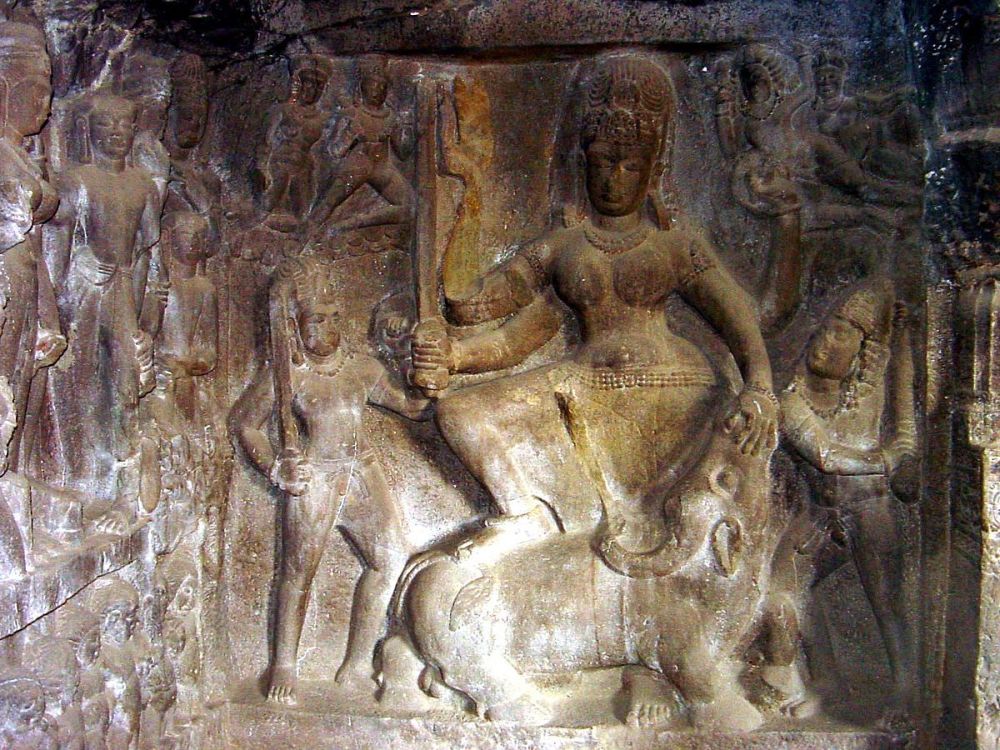

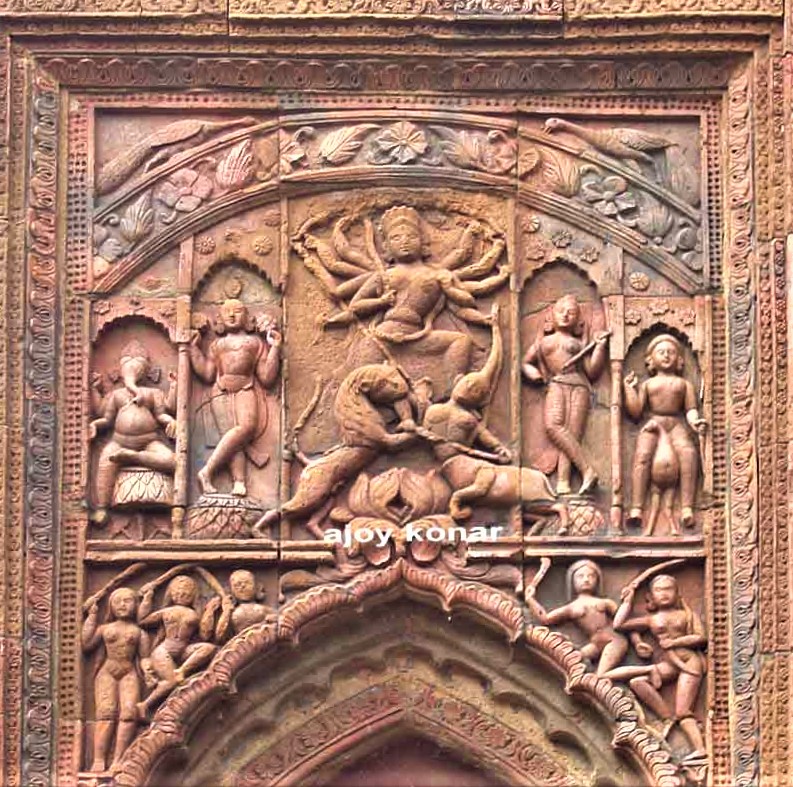
Devi Katyayani is worshipped on the 6th day of the Navratri as part of the navadurgas (9 manifestations of Durga) that takes during Durga puja. She is associated with awakening of the sixth chakra, which is the Ajna Chakra or the Third Eye, and she is invoked by focusing on this point.
Mahishasuramardini
Devi is generally depicted with ten hands, three eyes, a jata mukuta with a chandra-kala in it, her eyes are like the blue lotus, and her skin is like that of an atasi flower. In her right hands she carries khadga, chakra, saktyayudha (a spear), bow, and trisula. In her her left hands are seen ghanta, pasarau, khetaka, pasa, and ankusa. At her feet would be the cut head of a just killed buffalo or the Mahishasura should be seen coming out of the body of the buffalo with a sword in hand and her trisula plunged deep inside his neck. Devi’s right leg should be on the lion and her left leg placed firmly on the Mahishasura.



Mahishasura-vadh according to different Puranas
Varaha Purana– while devi Vaishnavi was doing tapasya on the Mandara mountain surrounded by her female attendants, Narada muni passed by and noticed the beautiful devi. He described her beauty to Mahishasura and the asura decided to marry her. With courtship and marriage in mind he sent the devi a messenger, who spoke of Mahishasura’s greatness, power, intelligence, bravery, story of his birth, and lineage. Jaya, an attendant of the devi, however sent the messenger back saying neither the devi nor her attendants were interested in marriage. Mahishasura took offence at the blunt refusal, and arrived with a large army to attack the devi. The devi and her attendants met them head on, and destroyed the entire army of the asuras.

Vamana Purana – the powerful asura king Mahishasura defeated all the gods; and the gods then led by Brahma went to Vishnu and Shiva for protection and help. After hearing the tribulations faced by the gods, flames of anger emitted from the eyes of Shiva and Vishnu and other gods and a large luminescence was created, from which emerged the trinayani devi Katyayani, shinning with the glory of thousand suns, hair as black as night, and with 18 hands. The gods armed her with their own weapons, and presented her with various ornaments, and a lion. The devi then moved to the Vindhya mountains. Two asuras Chanda and Munda who saw her when she arrived, informed their king Mahishasura about the arrival of a beautiful devi. The king after hearing of her beauty wanted to marry her, and sent Dundubhi, the son of Maya, to speak to the devi. Katyayani agreed to hear the message brought forth by Dundubhi, who then went on to praise Mahishasura, heaping the highest accolades on him. Katyayani agreed to marry Mahishasura, but on the condition that he do battle with her as a form of wooing, and if he could defeat Katyayani she would marry him. Mahishasura agreed to this condition, and came ready for a battle. Just prior to the battle the devi was given a shield by Vishnu to protect herself, as Mahishasura was deemed invincible owing to a boon by Shiva. When the battle started, the devi attacked the asuras with a barrage of arrows, and having caused havoc among their ranks she took up a vina and damaru and played them gleefuly. As the devi moved around playing the music, the bhootas and pretas accompanying her responded with shouts of joy and danced around her, while the lion tossed around the bodies of dead asuras. Seeing this, an enraged Mahishasura decided to go into a direct combat with the devi; and thus started a fierce war that carried on for a long time with both the devi and the asura king not showing any signs of defeat. Finally tired of it all, the devi jumped down from her lion and sprang up on the back of the mahisha, put her feet on his head, and cut it off in one stroke.
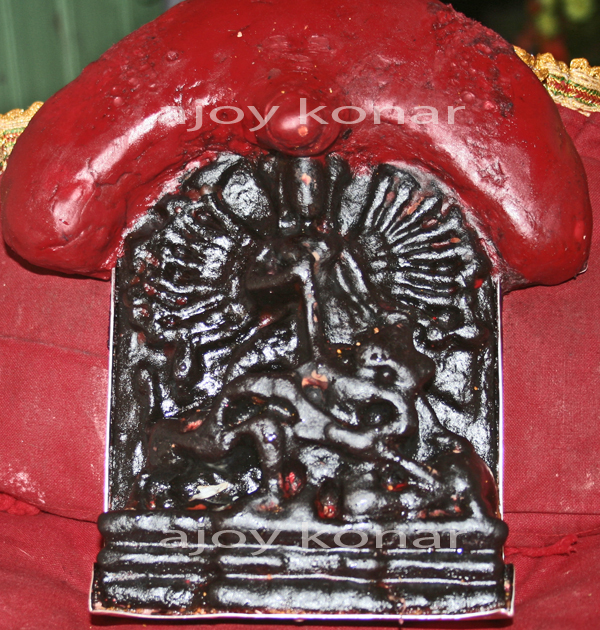
Vishnudharmottara– refers to the devi as Nanda. Here she is the daughter of Bharadvaja, is four armed, white skinned, and seated on an elephant. Of the four hands, the front two are in varada and abhaya poses, and the two back arms carry a padma and and an ankusa, or alternatively they may be holding a khetaka and a khadga. Varaha Purana also refers to Nanda, and here the devi appears as eight armed, wearing a kirita, and carrying sankha, chakra, gada, khadga, dhanus, pasa, bana, and ghanta. She kills Vetrasura, an asura who was disturbing the gods, after which the gods praised her and then made a prophesy that she will be called again in the future to kill Mahishasura.
In most of the other texts the stories of Mahishasura-vadh are similar to the one we find in Vamana Purana, with slight variations. The killing of Mahishasura is often seen as metaphorical; wherein the asura is an imagery representation of ignorance who is killed by knowledge or Jyana-sakti.
Mahisasuramardini from various temples in West Bengal (all photos provided by Ajoy Konar)

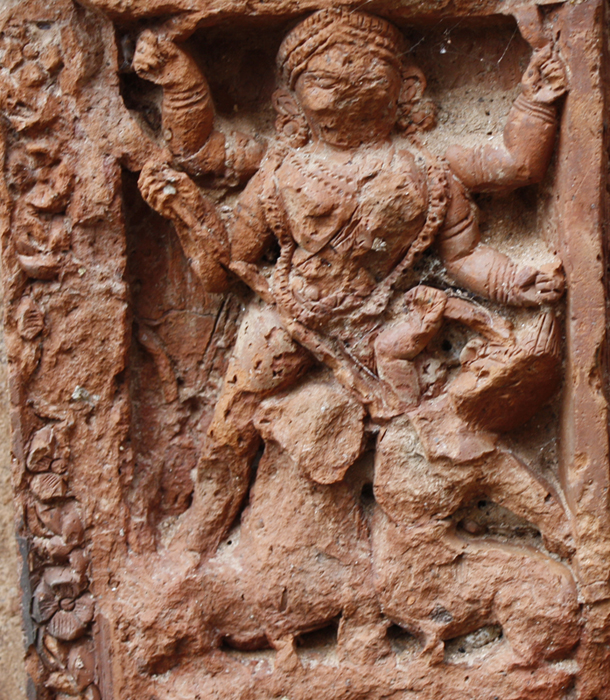
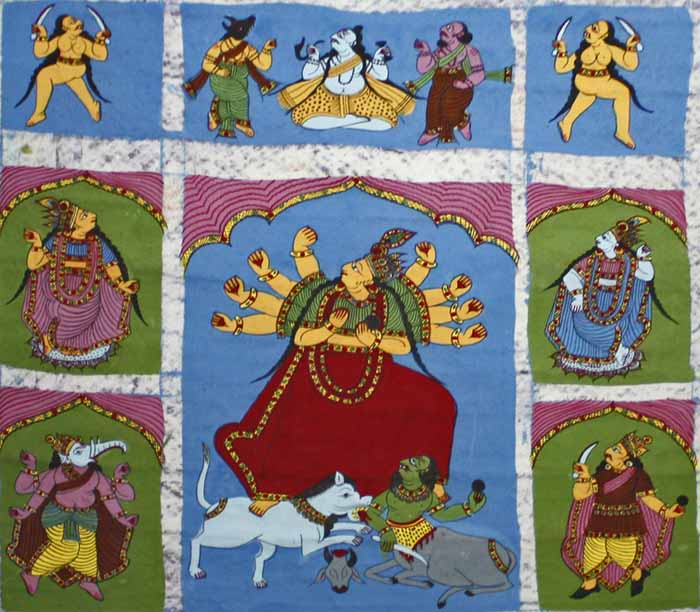
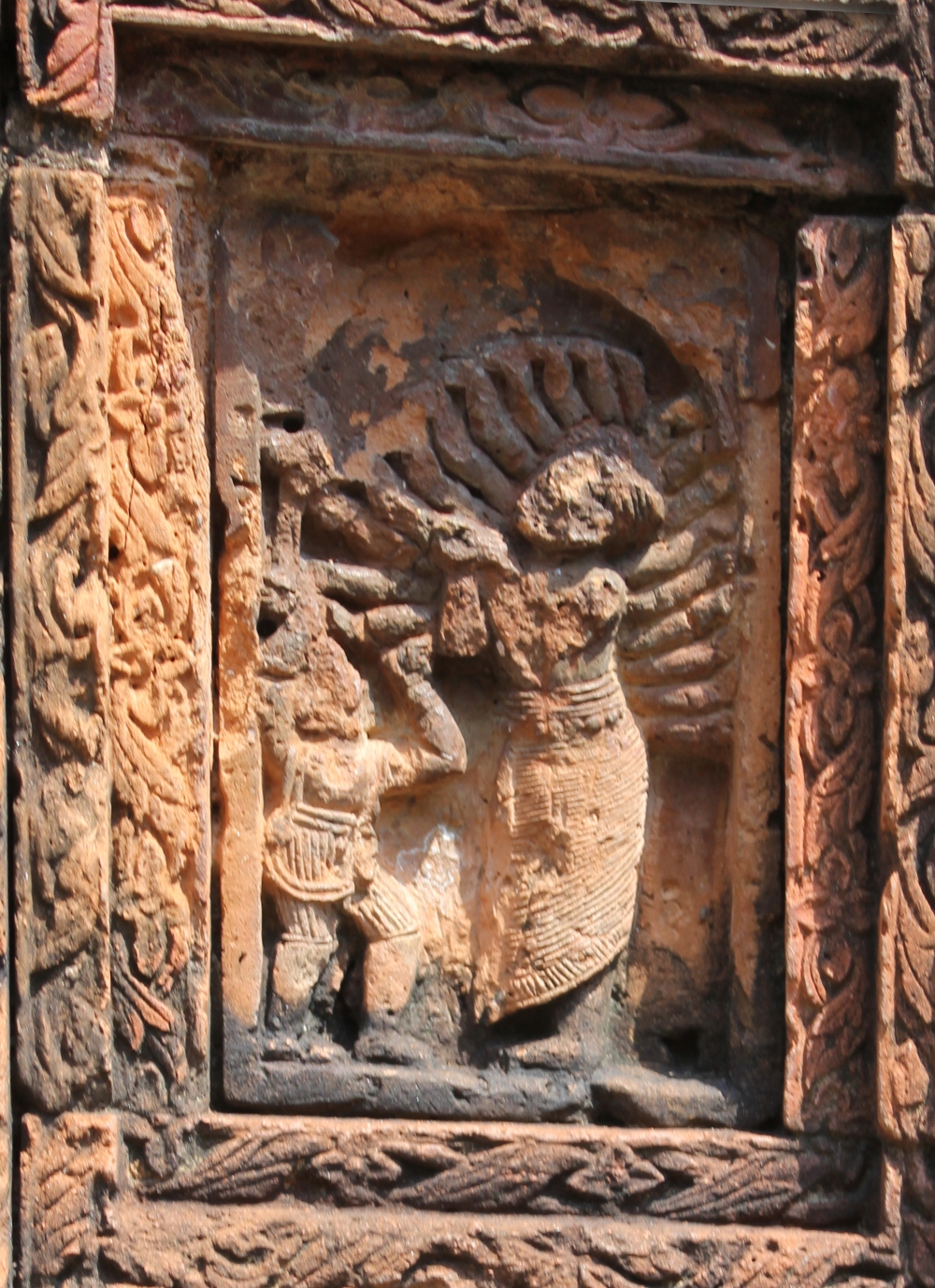
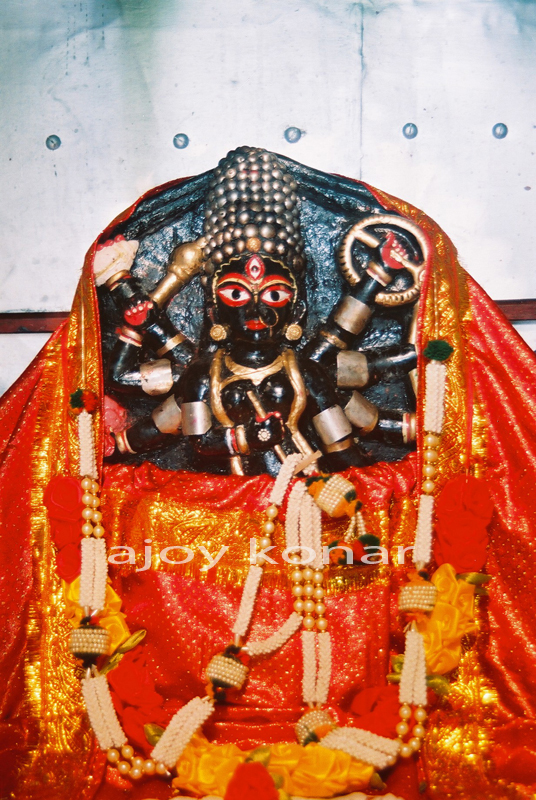



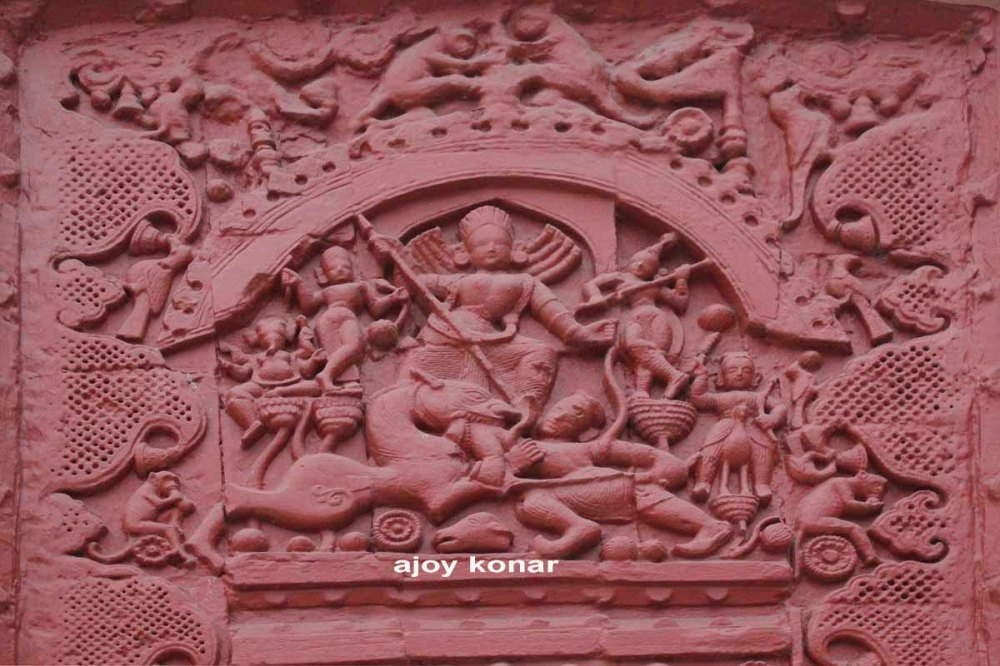

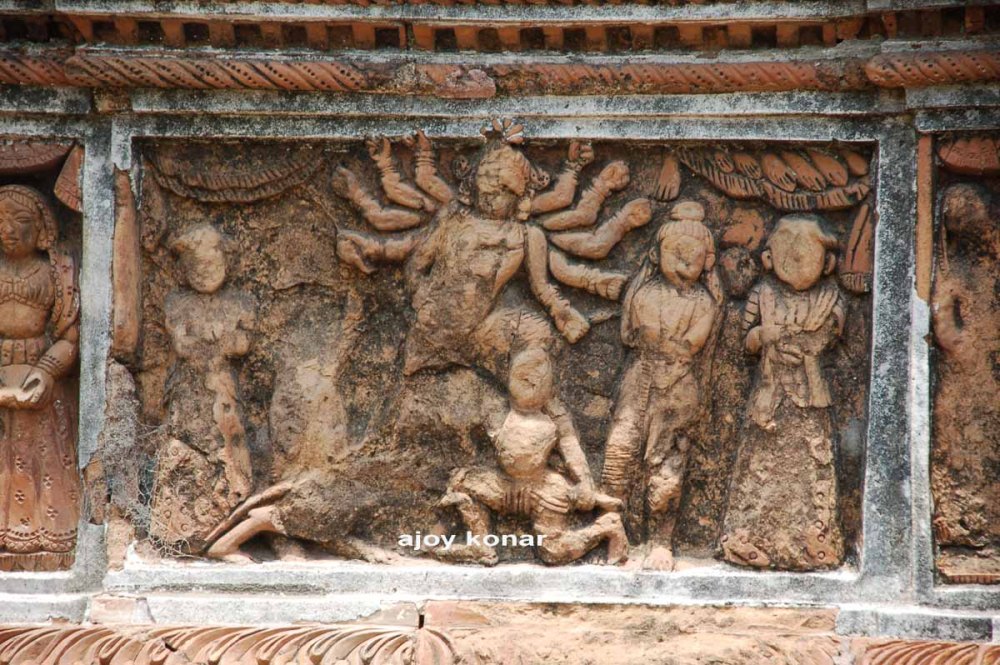
References
A. Coomaraswamy, Early Indian Iconography.
TNG. Rao, Elements of Hindu Iconography, Vol 1-part II.
S. Kramrisch, The Hindu Temple, Vol II.
J. Banerjea, Development of Hindu Iconography.
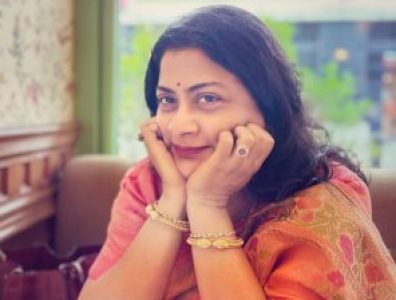
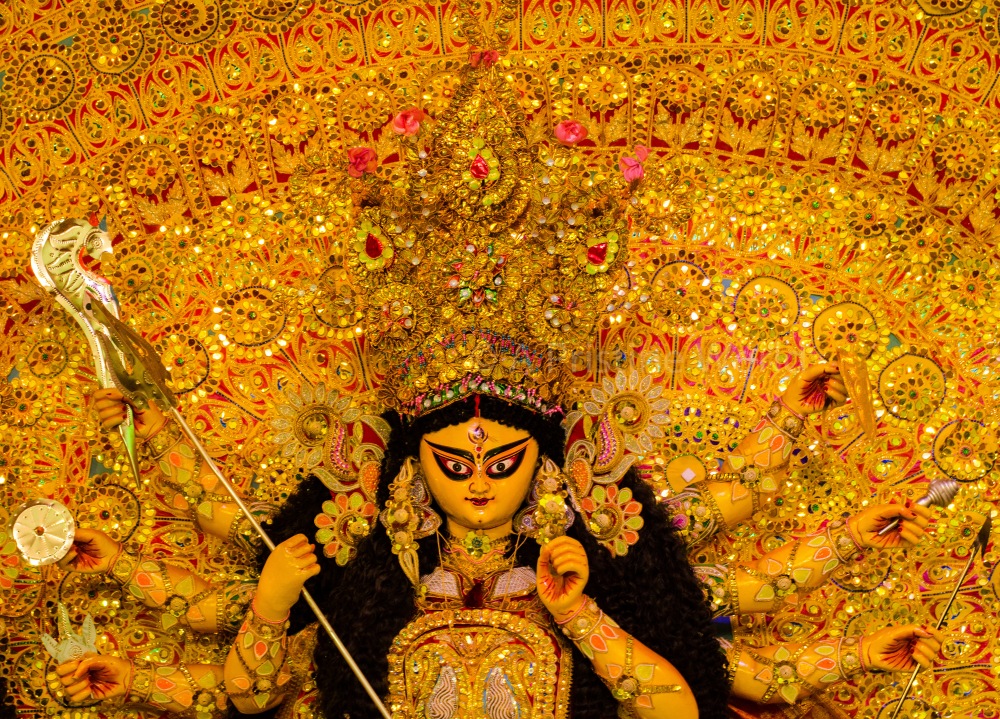


Excellent details of eary history of Indus civilisation , vedic period of Devi worship .
LikeLiked by 1 person
Thank you for reading it 😊😊
LikeLike
Many thanks for this post.
LikeLiked by 1 person
Thank you 😊
LikeLike
GOOD INFO. THANK U FOR SHARING. NAMASTHEJI
LikeLiked by 1 person
thank you
LikeLike
Thanks. Was waiting for such a post on Durga. Would like to know where n when did Durga worshipping started.
LikeLiked by 1 person
Durga in anthropomorphic form was popularised during the Kushana period. We see her on coins and seals from around 1st c. BCE which means her worship had started around that time or a little earlier, let’s say maybe around 3 c. BCE. Previously murtis were made mostly in wood so most didn’t survive. Then Later period vandalism destroyed the stone and metal ones.
LikeLike
Om Sakti Parashakti
LikeLiked by 1 person